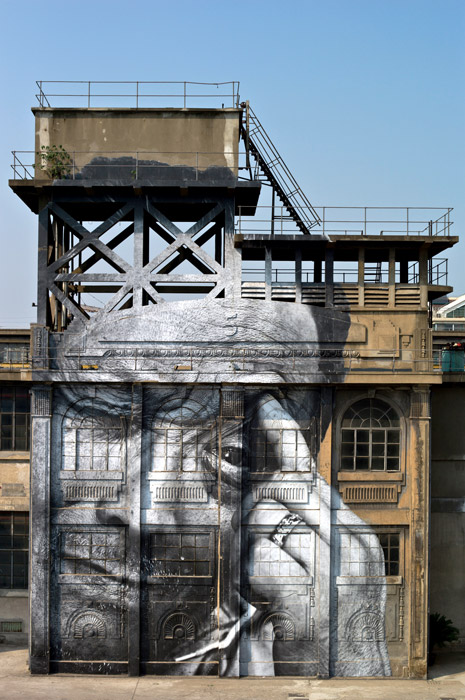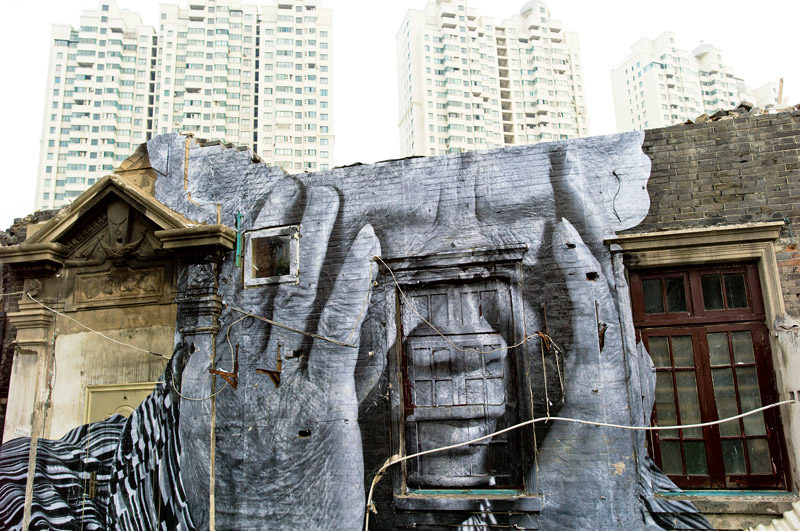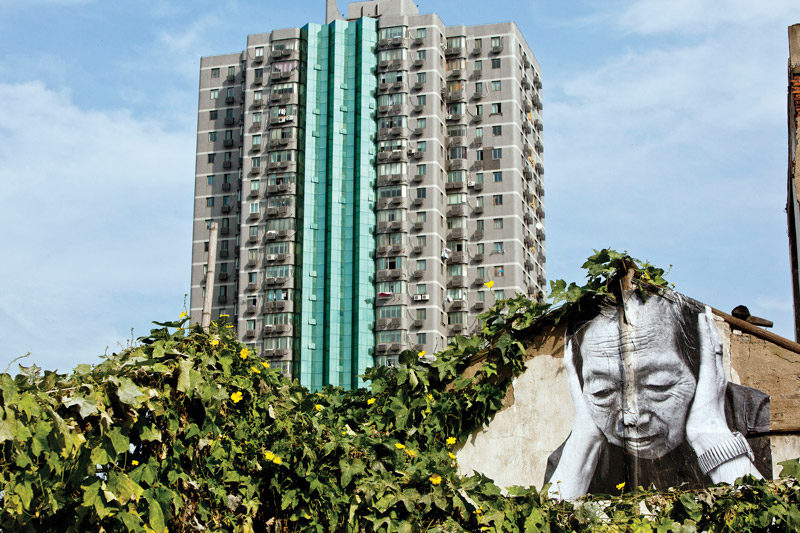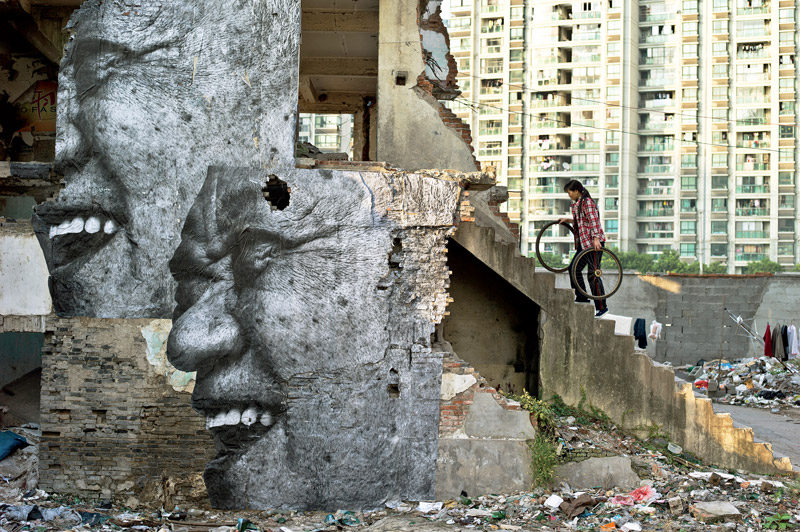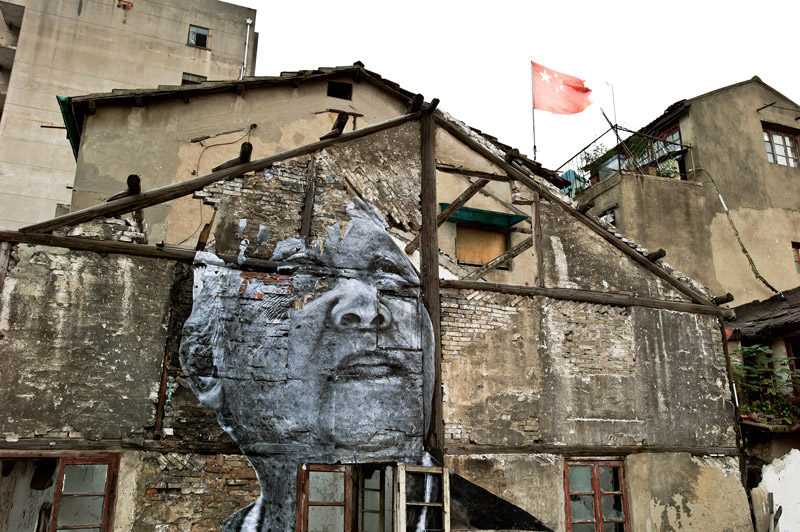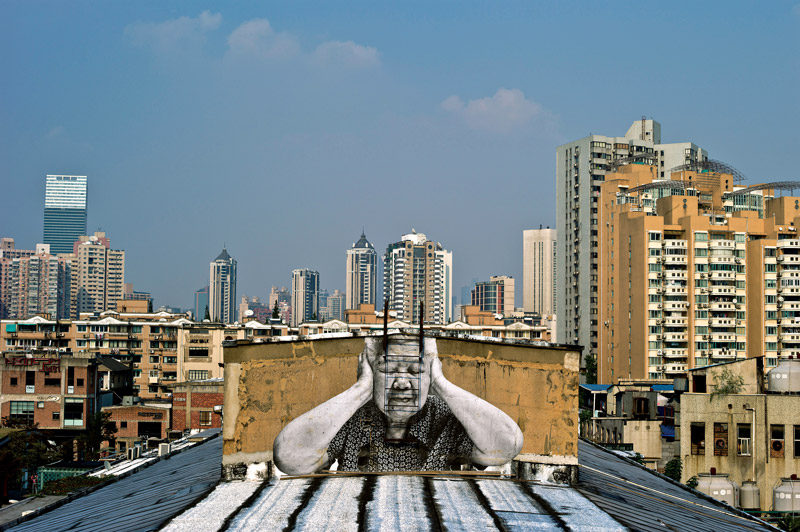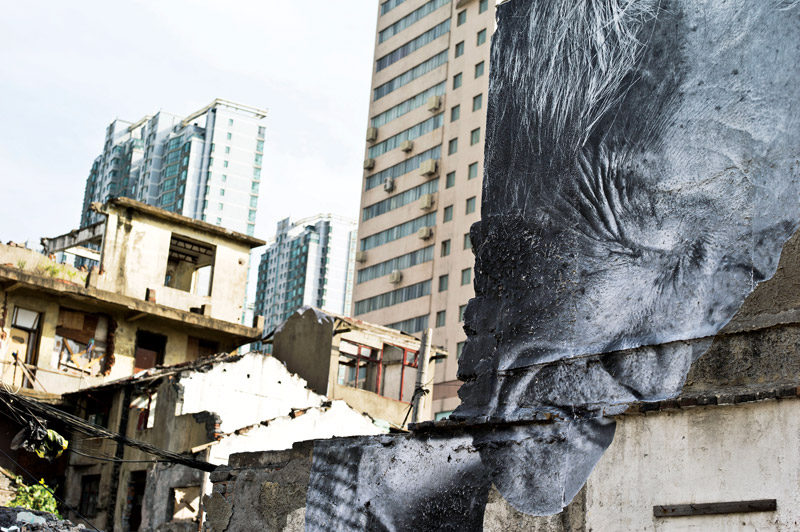[Winter 2012]
by John K. Grande
JR’s photography faces real life. The human faces that engage us in the real environments of the First and Third worlds are an exercise in self-identification within a larger matrix that is a seemingly invisible population of everyday people. Largely unrecognized, these people are off the map when it comes to social, political, or economic rights. JR puts them on the map, and he changes the map in the process. Early on, when the city of Paris was his graffiti playground, he chose when and where to leave an imprint, whether on a rooftop or in a tunnel or on the street. The goal was to leave a very visual signature, as he was well aware of the cultural values and biases in the quartiers or banlieue where he left his graffiti to engage a public. These first exchanges made him realize that he could produce art without a gallery. The city was his gallery.
After he found a cheap camera in a subway station, JR began to print documents of the traces he left. This would change his practice. Works on paper became street art that referenced the photo image. Around 2003, he began posting large-scale images in Rome and Paris. The human face was central to these images. When the November 2005 riots took place in Les Bosquets, a Paris suburb, JR decided to do something radical: he would visit those out-of-control kids seen attacking the cops and looting – the kids whom the public was so terrified of, although they had never encountered them in person. He asked them to grimace or make faces, and he captured portraits as close as ten inches to their faces. The process required trust on both sides – street kid and photographer. JR posted the images in the most bourgeois neighbourhoods of Paris. He even referenced the individuals in the photos, giving their names, ages, and addresses. A year later, in 2006, the same images of thugs, called Portrait of a Generation, were wrapped on the walls of Paris City Hall. The project inspired a working method that matched JR’s radical activism and would lead to his winning the 2011 TED Prize.
JR brings art into very risky and challenging cultural scenarios that involve high-risk gang, poverty, and intercultural tensions. He transforms real-life environments using large-scale photographic documentations of people whom he meets by chance. His practice has never relied, and doesn’t today rely, on public or corporate support. His resources are what they are, and he produces his projects with available materials, fellow artists, and volunteers, knowing the limitations of what he is working with. Photography in the way JR phrases it, and frames it, has social power and explores the structural and social malaise entrenched in societies all over the world.
The 28 Millimetres series started with “Portraits of a Generation” and went on to include “Face 2 Face” (2007), considered by some to be the largest illegal photo exhibition ever held. Undertaken in collabo-ration with JR’s business partner Marco, “Face 2 Face” took place in eight cities in Palestine and Israel. Displaying the faces of Palestinian and Israeli people right next to each other was a brave act, and it unmasked the official media myth that people on either side of the fence/wall were unassailably and irreconcilably unable to accept their adversaries.
In Hamas territory, on the Palestinian side of the wall, on an Israeli military tower, and elsewhere, JR’s postings captured the faces and gestures of ordinary people – taxi drivers, lawyers, cooks, and anyone else he encountered. He projected their images in a playful way, always in tandem with their Israeli or Palestinian counterpart. The whole project required twenty thousand square feet of paper, a car, some glue, and a ladder. The ladder was borrowed from the Church of the Nativity. When people asked JR and his crew what they were doing, he answered, “Can you tell me who is who?” Most could not say whether the specific faces in the images were Israeli or Palestinian. And nothing happened. No one was outraged. Even more interesting, the wall-posted photos are still there years later.
The “Women are Heroes” project was a worldwide one. Women, JR realized, are central stabilizers in poor and underprivileged communities worldwide and suffer disproportionately due to war, violence, and subjugation. Women comprise the real conscience of a society. JR collaborated with Médecins sans Frontières to bring disadvantaged women’s plight into focus. Travelling to the slums of Rio de Janeiro, Phnom Penh, Delhi, Liberia, and Kenya with his camera, he entered these communities and presented them with a mirror of themselves. Faces and eyes stare out from walls and roofs, villages and cities, speaking to us, revealing a full range of emotions. JR made these invisible people visible. In June of 2008, JR went to Providencia, a Rio de Janeiro favela to which the army had brought three students because they had no papers. In the favela, ruled by drug cartels, these youths were chopped to pieces. As he walked around Providencia, JR met a woman to whom he showed his book. The woman told him that the people there were hungry for, and needed, culture. JR and his crew encountered women – grandmothers, mothers, and relatives of the murdered youths – and he immediately got the green light from the Providencia community. JR told the drug lords that he wasn’t interested in the violence or weapons that obsessed the cartel, but in life in the community. They let JR and his crew do their thing. The first image they put up was of a grandmother of one of the victims. Images were pasted on virtually every available visible public space in the favela. When Brazilian media outlets heard about the event, they had to interview the women and families whose children had been murdered. JR was nowhere to be seen; he had already left.
When these personal histories are brought to light, they engage the communities that their subjects live in – communities that are also home to the perpetrators of such acts of aggression. The challenge enacted by an outsider can change people’s perceptions of themselves. In 2010, the film Women Are Heroes, shown at the Cannes Film Festival, received a long standing ovation from the audience.
JR’s current project, “Wrinkles of the City,” introduces works that raise questions about the way a city and its population remember themselves. In Cartagena, Spain, in 2008, photographs of an ageing population – the city’s foundation – were presented on outdoor walls and in environments that functioned as open-air galleries. The anonymity of the individuals whose faces were part of the art and the anonymity of the artist worked hand in hand. It was an exchange at the most immediate and direct level of life and culture. Democracy in action. An elderly man’s comment (in an interview by JR recorded in the project video document) sums it up: “Each one of my wrinkles and every one of my days here is carved on the building, on the street, and in the faces of each of the inhabitants of old Cartagena.” Shanghai’s older citizens communicated the wisdom of their experience for the next phase of “Wrinkles of the City” (2010). This is the same Shanghai that survived the Japanese occupation, the Communist Party’s coming of age, the Liberation, the Second World War, the end of the foreign concessions, Mao Zedong’s victory over Chiang Kai-Shek’s army, the Cultural Revolution, and what has been called the Great Leap Forward.
In 2011, the Los Angeles Freewall downtown project, curated by Daniel Lahoda, covered over a hundred thousand square feet of outdoor mural space, making the city the world’s largest outdoor art gallery and offering an American version of “Wrinkles of the City” in a west coast venue. The response was immediate and positive to the cultural infilling of an often desolate or purely commercial landscape of buildings, streets, cars, and people. And as winner of the pres-tigious 2011 ted Prize, he made his ted wish to use art to “turn the world inside out.” JR’s projects are ongoing. Sites are revisited. There is continuity and a long-term engagement with community and volunteers. Bridges are built over time with individuals. Photography becomes an art that engages dispossessed and invisible people where they live, all over the world. Bringing these people to light empowers them and gives them some insight into their shared situations.
JR (born 22 February 1983) is a French contemporary artist. His black-and-white photographs are exhibited in the street, which he calls “the biggest art gallery in the world.” Labelling himself an “urban activist,” JR tends to take art to where raw, unreferenced confrontation can still take place. His work is an expression of art and action and its themes include engagement, freedom, identity, and limits. He is represented by Galerie Perrotin in Paris.
John K. Grande is the author of Balance: Art and Nature (Black Rose Books, 1994), Art Nature Dialogues: Interviews with Environmental Artists (State University of New York Press, 2007, and Dialogues in Diversity: Art from Marginal to Mainstream, (Pari Publishing, Italy, 2008). He recently co-authored Bob Verschueren: Outdoor Installations (Editions Mardaga, Brussels (2010) and contributed to The New Earth Works (ISC Press, 2011). He recently co-curated “Eco-Art” with Peter Selz at the Pori Art Museum in Finland. Art & Ecology is being published in Shanghai in January 2012.

